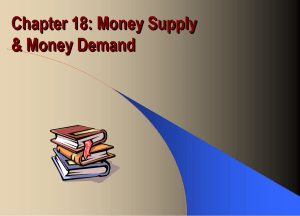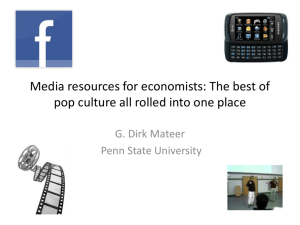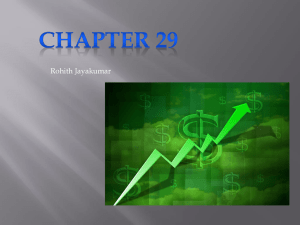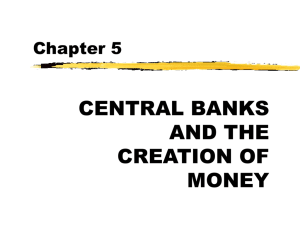Economics 302 Intermediate Macroeconomic Theory and Policy (Spring 2010)
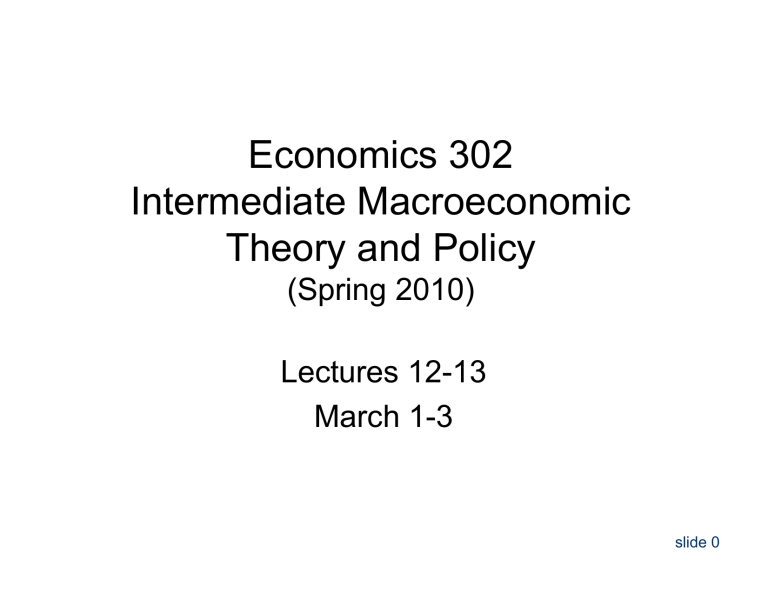
Economics 302
Intermediate Macroeconomic
Theory and Policy
(Spring 2010)
Lectures 12-13
March 1-3 slide 0
Outline
• How the Fed controls the money supply
- old version
- new version
• The demand for money, currency and checking deposits
• How the Fed traditionally conducts monetary policy
• Lags in the effect of monetary policy
• Accounting for recent changes slide 1
Fed Control of the Money Supply
• Fed directly controls Money Base
• The money supply consists of currency
(CU) and checking deposits (D) that individuals and firms hold at banks.
• The money supply M is therefore defined as:
M = CU + D
• Let’s refer to balance sheets slide 2
slide 3
Fed Control of the Money Base
(Pre-2008)
• The Fed controls the money supply by selling bonds to, or by purchasing bonds from, the banks, and the public (open market operations, or “OMO’s”
• The monetary base (M currency plus reserves:
B
) is defined as
M
B
= CU + RE
– The Fed does not try to exercise separate control of reserves and currency.
slide 4
Monetary Base/Money Supply Link
Reserve requirements.
• RE = rD
Currency demand.
• CU = cD
• From the definition of the money supply:
M = CU + D = cD + D = (1+c)D
M
B
= CU + RE = cD + rD = (c+r)D
• Dividing M by M
B
, we get ( m )
M
=
1
+ r
+ c c
M
B
, m
≡
1
+ r
+ c c
(14.5) slide 5
Excess and Borrowed Reserves
• In the US, the reserve requirement for banks is10 percent.
• Banks always keep some excess reserves.
• The amount of excess reserves has typically been small because banks didn’t use to receive interest on their reserve balances at the Fed.
• Banks can also increase their reserves by borrowing reserves from the Fed.
– Bank reserves borrowed from the Fed are called borrowed reserves.
– The Fed has traditionally provided loans to troubled banks.
slide 6
Excess Reserves and Borrowed
Reserves
• The Fed usually makes loans to banks at the borrowing “window” of one of the 12
District Federal Reserve Banks.
– The interest rate on the borrowings is called the discount rate .
– The discount rate used to be below Fed
Funds rate. Now above.
– Fed now pays interest on excess reserves.
slide 7
New M
B
/Money Supply Link
Reserves now depend on R
RES
.
• RE = ř D
Currency demand.
• CU = cD
• From the definition of the money supply:
M = CU + D = cD + D = (1+c)D
M
B
= CU + RE = cD + ř D = (c+ ř )D
• Dividing M by M
B
, we get a variable m
M
=
1 r
(
+
+ c c
M
B slide 8
Excess Reserves
Source: J. Hamilton, Econbrowser, Feb. 14, 2010.
slide 9
10
Relation of MB, M1 and M2
Lehman
9
Log M2
8
Log M1
7
6
5
1980 1985 1990 1995
Log Money
Base, nsa
2000 2005 2010 slide 10
Distinguishing between Monetary and Fiscal Policies
• Fiscal policy is defined as bond-financed changes in government expenditures and taxes.
– The monetary base and the money supply remain unchanged, and bonds are issued if government spending increases or taxes are reduced.
slide 11
Distinguishing between Monetary and Fiscal Policies
• Monetary policy is defined as a change in the monetary base matched by a change in government bonds in the opposite direction.
– This exchange of money for bonds is an open-market operation .
– Note that open-market operations do not affect government purchases ( G ), transfers
( F ), interest payments ( Q ), or taxes ( T ).
Hence, open-market operations do not affect fiscal policy.
slide 12
The Demand for Money
• Three motives in people’s demand for money:
• transactions motive,
• precautionary motive,
• speculative motive.
slide 13
The Transactions Demand for Money:
An Inventory Theory
• Families and businesses hold currency and keep funds in their checking accounts for the same reason stores keep inventories of goods for sale.
– Because income is received periodically and expenditures occur every day, it is necessary to hold a stock of currency and checking deposits.
– This inventory theory of the demand for money falls into the category of transactions motive.
slide 14
slide 15
Inventory Theoretic Approach
kW
2 M kW
+
R M = T o t C ost
0
=
M
2
2 R
0
M
= kW
2 R slide 16
The Demand Function for Money
• We can summarize the demand for currency and checking deposits in two demand functions:
CU = CU( R , PY )
D = D ( R , PY )
– The equations show that the demand for currency and the demand for checking deposits are functions of the market interest rate R and nominal income PY (the price level
P times real income Y ). slide 17
14.4 HOW THE FED CONDUCTS
MONETARY POLICY
• How should the Fed use its power to achieve its objectives of keeping inflation low and economic fluctuations small?
• Decisions about monetary policy in the
United States are made by the Federal
Open Market Committee (FOMC).
slide 18
Setting Interest Rates or Money
Growth
• FOMC alternatives for monetary policy:
–
Set the growth rate of the money supply.
–
Set the short-term interest rate.
–
Money supply setting is preferable if shifts in the IS curve dominate.
–
Interest rate setting preferable if shifts in the LM curve dominate.
slide 19
slide 20
slide 21
The Zero Bound on Nominal
Interest Rates
• What are the implications for the conduct of monetary policy when nominal interest rates approach or equal zero?
• The constraint of a zero bound on the nominal interest rate limits the scope of monetary policy.
• If the nominal interest rate is zero, it cannot be lowered any further to stimulate the economy.
slide 22
The Zero Bound on Nominal
Interest Rates
• Deflation is negative inflation (falling prices).
• With deflation, a zero nominal interest rate produces a positive real interest rate.
• This may be too high to stimulate the economy, and cannot be lowered any further.
slide 23
20
16
12
8
United
States
4
Japan
0
1980 1985 1990 1995 2000 2005 2010
Japanese and US money market rates. Source: IMF, IFS , and St. Louis Fed slide 24
20
Zero Bound in America
Fed Funds
16
12
8
4
0
70 75 80 85 90 95 00 05 slide 25
Lags in Monetary Policy
• Monetary policy affects real GDP and prices with a lag.
• The evidence suggests that the peak effect of monetary policy on GDP occurs after a lag of between one and two years.
• Uncertainty about the future state of the economy adds to the caution of monetary policy makers. slide 26




